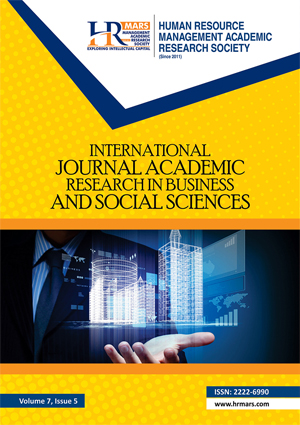
ISSN: 2222-6990
Open access
The progress of artificial intelligence technology has led to the rise of quantitative trading systems, particularly those using reinforcement learning, in the stock trading market. In this article, the deep Q network in reinforcement learning is combined with the emotional quantitative indicator ARBR to develop a high-frequency stock trading model specifically for the Chinese A-share market. In order to improve the model’s performance, this study employs the PCA algorithm to reduce the dimensionality of the feature vector and incorporates the impact of market sentiment on long-short power into the spatial state of the trading model. Furthermore, the LSTM layer is used in place of the fully connected layer to overcome the limitations of empirical data storage in the traditional DQN model. This paper analyzes the model's performance based on cumulative income and the Sharpe ratio, while also comparing it to other approaches like the double moving averages strategy. The data indicates that the suggested model exceeds the comparison model in return rates, with a maximum annualized return of 54.5%, emphasizing its ability to substantially improve Reinforcement Learning results in stock trading.
Ta, V. D., Liu, C. M., & Tadesse, D. A. (2020). Portfolio optimization-based stock prediction using long-short term memory network in quantitative trading. Applied Sciences, 10(2), 437.
Liu, Y. (2020). Adaptive quantitative trading: An imitative deep reinforcement learning approach. In Proceedings of the AAAI Conference on Artificial Intelligence, 34(02), pp. 2128-2135.
Li, Y., & Tang, S. (2021). Stock liquidity, investor sentiment and stock price collapse risk. Journal of Hebei University of Technology (Social Science Edition) (03), 18-29.
Jiang, F., Meng, L., & Tang, G. (2021). Media text sentiment and stock return forecast. Economics (Quarterly) (04), 1323-1344.
Cai, Q. (2021). Analysis of the influence of media sentiment on stock returns. Master's thesis, Zhejiang University.
PAUL C. TETLOCK. (2007). Giving Content to Investor Sentiment: The Role of Media in the Stock Market. The Journal of Finance, 62(3), p1139-1168.
Jiang, Y. (2011). Investor Sentiment and Stock Market Response to Earnings Announcement. 2011 International Conference on Management and Service Science, Wuhan, China, pp. 1-4
Li, Y. (2018). Research on stock buying and selling point prediction based on integrated learning. Master's thesis, Northwest University.
Zhang, W., & Wang, W. (2014). Stock market prediction based on deep learning. Journal of Wuhan University, 39 (1): 1-7.
Yang, Q., & Wang, C. (2019). Research on global stock index prediction based on deep learning LSTM neural network. Statistical Research, 36(03): 65-77.
Sun, D., & Bi, X. (2018). High-frequency trading strategies based on deep learning algorithms and their profitability. Journal of University of Science and Technology of China, 48(11): 923-932.
Wang, Y., & Xu, Y. (2019). Research on feature extraction and prediction of multiple stock information based on LSTM. Modern Economic Information, 2019 (03): 325.
Rong, Z. (2020). Deep reinforcement learning stock algorithm trading system application. Computer Knowledge and Technology, 16(23): 75-76.
Zhu, K., & Liu, R. (2020). The selection of reinforcement learning state and value function applied to portfolio optimization. Journal of Fuzhou University (Natural Science Edition), 48 (02): 146-151.
Deng, Y., & Bao, F. (2017). Deep Direct Reinforcement Learning for Financial Signal Representation and Trading. Transactions on Neural Networks and Learning S ystems, 3:653-664.
Bekiros, S. D. (2010). Heterogencous trading strategies with adaptive fuzzy actor-critic reinforcement learning: A behavioral approach. Journal of Economic Dynamics and Control? 34(6):11, 53-1170.
Uriel, C. B., Rolando, M. M., & Ricardo, M. M. (2020). On the Computation of Optimized Trading Policies Using Deep Reinforcement Learning. Telematics and Computing, 2020(10): 83-96.
Liu, W. (2021). Stock data mining method and its application based on deep learning. University of Chinese Academy of Sciences (Shenzhen Institute of Advanced Technology, Chinese Academy of Sciences).
Dai, X., & Zhang, S. (2021). Application of stock trading based on reinforcement learning method. Operation and Management, 2021(03): 23-27.
Qiao, H., & Yang, L. (2016). Analysis of the Systemic Risk Contributions of the CSI 300 Index Constituents-A Research Based on the Related Networks of Stock Indexes. Journal of Central South University (Social Science Edition), 03, 114-123.
Chang, P. C., & Wu, J. L. (2015). A critical feature extraction by kernel PCA in stock trading model. Soft Computing, 19(5), 1393-1408.
Kupiec, P. (1995). Techniques for verifying the accuracy of risk measurement models. The Journal of Derivatives, 3(2).
Wang, C. (2008). High-frequency extreme value conditional VaR model based on extensive extreme value distribution. Journal of System Management, 03, 261-265+272.
Li, Y., Salam, Z. A., Xiong, H., & Zhou, P. (2025). An Improved Reinforcement Learning Model Based on Sentiment Analysis. International Journal of Academic Research in Business and Social Sciences, 15(4), 688–703.
Copyright: © 2025 The Author(s)
Published by HRMARS (www.hrmars.com)
This article is published under the Creative Commons Attribution (CC BY 4.0) license. Anyone may reproduce, distribute, translate and create derivative works of this article (for both commercial and non-commercial purposes), subject to full attribution to the original publication and authors. The full terms of this license may be seen at: http://creativecommons.org/licences/by/4.0/legalcode